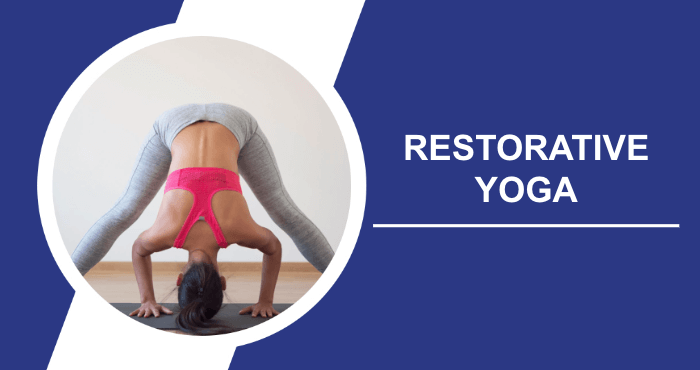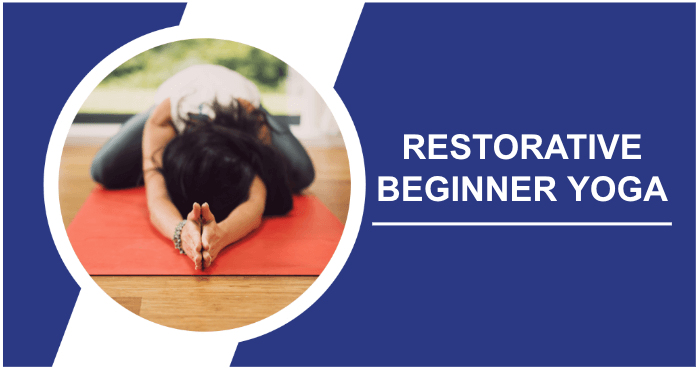Are you tired of diets and spending endless hours at the gym? Is yoga a weight loss option? Restorative yoga involves practicing postures, known as asanas, for specific durations while using props for support.
In fact, yoga practice not only helps to lose weight and achieve a better physique. It is also the most effective way to reduce stress. It calms your body and mind, leaving you feeling more balanced and less stressed. In this article, you will learn more about restorative yoga for weight loss and the benefits of practicing yoga.
Is Restorative Yoga Beneficial?
Yes, it is. Here are some of the benefits of yoga for weight loss that you may not be aware of:
- Improved well-being
- Improved sleep patterns
- Relief from chronic pain
- A more relaxed nervous system
- Reduced stress
How Often Should I Practice Restorative Yoga?
Restorative Yoga is best practiced for optimal deep relaxation and stress relief. However, if you have a schedule, practicing 1 or 2 times a week can still offer substantial benefits and help maintain flexibility. It’s important to tune into your body’s needs and adjust your practice accordingly.
How Can Restorative Yoga Help With Weight Loss?
In fact, a prolonged yoga pose combined with deeper breathing is essential in restorative yoga for shedding pounds. This creates a relaxation response that is remarkably beneficial for your body. It lowers blood pressure and calms your muscles, releasing tension.
One of the advantages of practicing restorative yoga is its impact on the body as it promotes changes in behavior. This form of yoga brings relaxation to every part of the body, including the torso, legs and even the mind. Essentially it helps reduce stress levels in your body, which plays a role in achieving weight loss. There are health benefits associated with restorative yoga that can contribute to your overall well-being and help you achieve your weight loss goals:
1. Improve Well-Being
Along with good health, one of the most important elements for your body is well-being. Studies show that practicing yoga has a number of therapeutic benefits that can help you feel better. It’s also much easier to burn calories and lose weight when your body is happy.
Embrace restorative yoga and gain greater mindfulness. With each pose, you inhale deeper, achieve a healthy weight and take a broader view of your life and the cosmos. It also means less fatigue-related body aches and pains, and more vitality to enjoy each day.
2. Improved Sleep Cycles
Did you know that not getting enough sleep can actually hinder your weight loss goals? When you don’t get enough sleep, your body can’t fully relax. However, it can be difficult to get sleep when you’re feeling tense and stressed out. That’s where restorative yoga comes in. By practicing poses, it helps to calm both your body and mind. Studies indicate that restorative yoga may have the potential to enhance sleep quality by triggering changes and reducing cortisol levels.
3. Relieves Chronic Pain
Each asana in restorative yoga uses supports and involves stretching. Stretching is essential if you have chronic pain and want to release body tension. Your body becomes less sensitive to pain. This is particularly important for women’s well-being, according to a study of older women. Consistent yoga practice reduces pain levels. The effect of each pose is enhanced by deeper breathing and increased concentration. To learn more about chronic pain relief, daily asana practice promotes relaxation.
4. Calming The Nervous System
Restorative yoga incorporates postures, each of which involves the use of supports and gentle stretching. Stretching plays a role in relieving chronic pain and releasing tension from the body. Over time the body becomes less responsive to pain signals, which can significantly benefit wellbeing, especially for older women as indicated by a study. Regular practice of yoga helps reduce pain levels while simultaneously enhancing the effects of each posture through breathing and increased focus. Engaging in daily asana practice fosters relaxation. Provides valuable insights, into finding relief from chronic pain.
5. Reduces Stress
Left unchecked, stress can take over your mind and body. Fortunately, over time, restorative yoga has proven to be a successful remedy. People have used these poses to relax and relieve stress. It’s a time-honoured and effective technique. It’s even more beneficial for reducing anxiety, especially if you have a chronic illness. Eliminating stress increases the likelihood that treatments will restore your body to optimal health. Once you have understood its many benefits, you may wish to try a few asanas to get started.
Is Restorative Yoga Suitable For Beginners?
Restorative yoga is an option for people who are new to yoga. It centers around relaxation and gentle stretching incorporating props like blankets and bolsters to provide support for the body. The focus is on holding poses for periods of time which promotes deep relaxation and helps reduce stress. Its gentle nature makes it particularly well-suited for beginners, individuals with mobility or those who prefer a soothing practice. It serves as an introduction to the world of yoga, in a non-intimidating and calming manner.
3 Rejuvenating Yoga Poses To Lose Weight
If you are looking for a professional guide to rejuvenating yoga, start with the three poses highlighted in this article. They are easy to do, and you can expand and refine them as your expertise grows.
1. Child’s Pose
To begin the process of reducing fat in your body, you can start with a specific yoga pose. It’s quite simple: Start by sitting on your heels. Make sure you have a high-quality yoga mat for comfort and stability. Keep your knees apart. Gently lean forward. As you bend your body, allow your belly to rest between your thighs. Then, place your forehead on the mat. Extend your arms forward. Stay in this facing position while inhaling and exhaling comfortably.
With further exploration, you’ll discover that there are many different child poses possible. For a more therapeutic yoga experience, consider placing a bolster between your legs.
2. Supine Bound Angle Pose
Gentle yoga is a beneficial approach for overweight women who want to lose weight. The poses are simple, such as the supine bound angle pose. Start by lying on your back with your knees bent and your pelvis close together. Bring your knees as close together as possible, then spread them out to the sides of your body. Connect the soles of your feet and place blocks under each knee for stability.
Keep in mind that these activities are designed to help you feel calm and relaxed. Use some objects or tools as aids for support. Take your time to rest and unwind while inhaling gently without putting much pressure on your body. Additionally practicing breathing, for around five minutes can also help strengthen your core muscles.
3. Supported Forward Bend
The third pose to try is the supported forward bend. Start by sitting on a mat on the floor, then roll out an additional yoga mat to rest on your legs. Make sure the mat is resting on your straight legs before continuing. Bend your torso forward until your forehead touches the mat on your thighs. You can bend further and briefly rest your face on the mat. Let your arms rest next to your legs. Calm and regular breathing is also important in this pose.
These three yoga exercises have the potential to significantly enhance your health and well-being. Additionally, practicing these poses can effectively lower cortisol levels in your body, which is especially beneficial for overweight women. It is crucial to maintain a sense of calm and reduce stress while prioritizing loss. Furthermore, these poses can help alleviate anxiety and promote a positive emotional state.
How Much Does A Restorative Yoga Class Cost?
The cost of a restorative yoga class can vary greatly depending on location, the experience level of the teacher and the setting (e.g. local studio vs. luxury retreat). Typically, a single class can cost between $15 and $25 in urban areas and slightly less in smaller towns. Packages or membership plans can reduce the cost per class. Some studios also offer sliding scale fees or community classes at a reduced rate to make them more accessible. Prices may be higher for special workshops or classes taught by renowned instructors.
What Is Restorative Yoga?
Restorative yoga is a choice for individuals aiming to shed pounds and alleviate stress. This form of practice involves holding poses for periods promoting gentle stretching of the body. While it may not burn calories as rapidly as some other exercises, restorative yoga offers accessibility and benefits to people of all fitness levels. Essentially it involves performing soothing sun salutations in a manner that allows each pose to induce relaxation, with minimal exertion throughout a session.
These postures, called asanas, have many benefits. Sun salutations are a series of asanas designed to rejuvenate the body and mind. To get started with restorative yoga, find a qualified yoga instructor. The practice requires the use of a yoga mat, blankets, and various tools. Proper yoga practice helps with weight management and promotes relaxation.
During the practice of asanas, calories are burned. Restorative yoga, which includes yoga, involves visualizing your desired body weight and focusing on that image while controlling your breath. In yoga, props are often used to provide support to the body enabling you to effortlessly hold each pose. As your body starts to relax and unwind you will experience a decrease in tension and an increase in mental clarity. Your goal is to perform the yoga postures while maintaining control over your breathing. Pay attention to any thoughts that arise during your meditation session.
What Equipment Do I Need For Restorative Yoga?
For restorative yoga, you’ll need a yoga mat for comfort and support. Bolsters provide essential support for poses, while yoga blocks help with alignment and stability. Yoga straps help with reaching and holding poses, especially for flexibility challenges. A blanket provides additional cushioning and warmth for relaxation. Eye cushions are optional, but can enhance relaxation by blocking out light. Taken together, this equipment creates a supportive, comfortable environment, essential for the restorative aspect of this yoga practice.
Frequently Asked Questions
What are some of the best restorative yoga poses?
There are yoga positions that can enhance your body’s shape and induce a sense of calmness. Some notable ones include the dog boat pose, cobra pose, child’s pose, reclined bound angle pose, and supported forward fold. These postures offer benefits and involve focusing on deep breaths while transitioning between them.
Why is restorative yoga beneficial?
Restorative yoga is particularly effective for the well-being of the body and mind. Practicing yoga poses helps prevent weight gain and increases mental clarity. Fortunately, many yoga teachers offer excellent classes.
Can restorative yoga be practised daily?
Restorative yoga, a calming style of yoga that incorporates the use of props to reduce intensity is known for minimizing stress on the body. This makes it an ideal choice, for practice, especially for those looking to manage their weight. Moreover engaging in restorative yoga sessions has been shown to greatly enhance mindfulness.
How Long Are Typical Restorative Yoga Sessions?
Sessions usually last between 45 minutes and an hour, allowing plenty of time for relaxation and meditation in each pose.
Is Restorative Yoga Safe for Everyone?
It’s usually considered safe for most individuals. However, if you have any health issues or injuries, it would be advisable to seek guidance from a healthcare professional or a certified yoga instructor.
Final Thoughts
How does yoga help you lose weight? Participating in restorative yoga has far-reaching benefits for both your physical and mental health. Achieving your weight goals is easy with each pose, reducing stress levels. This style of yoga uses tools to ensure that the exercises are not too strenuous. As well as reducing belly fat, this therapeutic approach to yoga has significant benefits for your nervous system. It also improves general well-being and helps to alleviate chronic conditions.
If you’re just starting out a way to begin is by focusing on three fundamental asana poses mentioned in this article. Not will they assist in your relaxation but they also contribute to burning calories while you practice. Additionally these poses offer benefits, for your health leaving you feeling improved for an extended period of time.
Sources
- Nedeltcheva, A.V., Kilkus, J.M., Imperial, J., Schoeller, D.A., and Penev, P.D. (2010). “Insufficient sleep undermines dietary efforts to reduce adiposity.” Annals of Internal Medicine, 153(7), pp.435–41. Read Article.
- Corey, S.M., Epel, E., Schembri, M., Pawlowsky, S.B., Cole, R.J., Araneta, M.R.G., Barrett-Connor, E., and Kanaya, A.M. (2014). “Effect of restorative yoga vs. stretching on diurnal cortisol dynamics and psychosocial outcomes in individuals with the metabolic syndrome: The PRYSMS randomized controlled trial.” Psychoneuroendocrinology, 49, pp.260–271. Read Article.
- Corey, S.M., et al. (2014). “Effect of restorative yoga vs. stretching on diurnal cortisol dynamics…” Psychoneuroendocrinology, 49, pp.260–271. Read Article.
- Schmid, A.A., Fruhauf, C.A., Sharp, J.L., Van Puymbroeck, M., Bair, M.J., and Portz, J.D. (2019). “Yoga for People With Chronic Pain in a Community-Based Setting: A Feasibility and Pilot RCT.” Journal of Evidence-Based Integrative Medicine, 24, p.2515690X1986376. Read Article.
- Seguin-Fowler, R., Graham, M., Ward, J., Eldridge, G., Sriram, U., and Fine, D. (2020). “Feasibility of a yoga intervention to decrease pain in older women: a randomized controlled pilot study.” BMC Geriatrics, 20(1). Read Article.
- Woodyard, C. (2011). “Exploring the therapeutic effects of yoga and its ability to increase quality of life.” International Journal of Yoga, 4(2), p.49. Read Article.
- Zetzl, T., Renner, A., Pittig, A., Jentschke, E., Roch, C., and van Oorschot, B. (2020). “Yoga effectively reduces fatigue and symptoms of depression in patients with different types of cancer.” Supportive Care in Cancer, 29(6), pp.2973–2982. Read Article.
- Raghavendra, R.M., Vadiraja, H.S., Nagarathna, R., Nagendra, H.R., Rekha, M., Vanitha, N., Gopinath, K.S., Srinath, B.S., Vishweshwara, M.S., Madhavi, Y.S., Ajaikumar, B.S., Ramesh, B.S., Nalini, R., and Kumar, V. (2009). “Effects of a Yoga Program on Cortisol Rhythm and Mood States in Early Breast Cancer Patients Undergoing Adjuvant Radiotherapy: A Randomized Controlled Trial.” Integrative Cancer Therapies, 8(1), pp.37–46. Read Article.
- Katuri, K., Dasari, A., Kurapati, S., Vinnakota, N., Bollepalli, A., and Dhulipalla, R. (2016). “Association of yoga practice and serum cortisol levels in chronic periodontitis patients with stress-related anxiety and depression.” Journal of International Society of Preventive and Community Dentistry, 6(1), p.7. Read Article.
Mark Willson, holding a Ph.D., functions as a psychotherapist in Washington, D.C. His specialized fields encompass addiction, anxiety, depression, as well as sexuality and interpersonal connections. Dr. Willson holds the distinction of being a diplomat for the American Board of Addiction and Anxiety, further serving as a certified counselor and addiction specialist.
Aside from his personal professional endeavors, Dr. Wilson has engaged in roles as an author, journalist, and creator within substantial medical documentary projects.
Isabella Clark, Ph.D., held the position of a professor within Emory University’s School of Medicine, working in the Department of Mental Health and Nutrition Science. Alongside this role, she served as a research associate affiliated with the National Research Center. Dr. Clark’s primary area of research centers on comprehending the mechanisms through which adverse social encounters, encompassing prolonged stress and traumatic exposure, contribute to a spectrum of detrimental mental health consequences and coexisting physical ailments like obesity. Her specific focus lies in unraveling the reasons behind the varying elevated susceptibility to stress-linked disorders between different genders.






